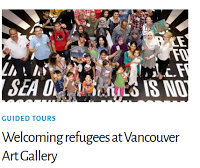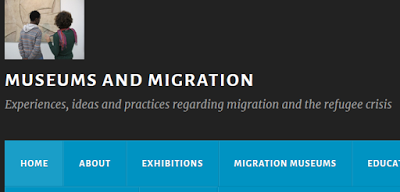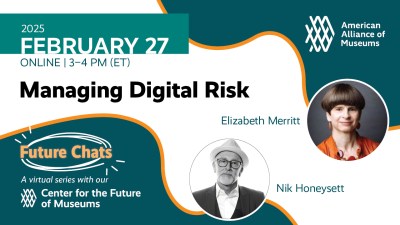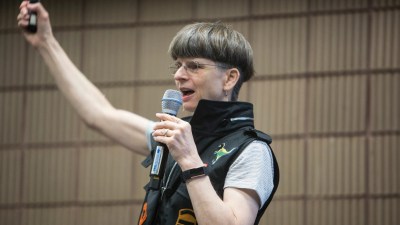
Mass migration, driven by conflict, oppression, political upheaval, climate change and economic distress, has been described as “the defining issue of this century.” As such, it is one of many critical issues that museums can address in our collective duty to create a better, just and more equitable world. In searching for stories related to this driver of change, I came across Museums and Migration, a website started earlier this year by Anna Chiara Cimoli and Maria Vlachou that documents experiences, ideas and practices regarding migration and the refugee crisis. Anna is an art historian and museum mediator based in Milan, and Maria is a cultural management and communications consultant as well as founding member and executive director of the association Acesso Cultura. (You can read more about them here.) For today’s post, they graciously agreed to answer some questions about the site, and about the work museums are doing to support migrants and their communities.
Maria and Anna, what prompted you to start the “Museums and Migration” site? Do current events in the world make this particularly important now?
We met on the social media through professional networks and we realized that we shared the same concerns and the same convictions regarding the role of museums in building a better society: more human, more just, more inclusive and less ignorant. We decided to create a platform that could be useful for the whole sector, bringing together current museum thinking and practice regarding migration and the ‘refugee crisis’. A platform that would give visibility to projects which may be an inspiration for others.
Migration is not a new issue, although many museums never touched on it: either because they didn’t think they had anything to do with it; or because it is a sensitive issue; or because of the assumption that museums are neutral. The issue became more pressing, though, with the refugee crisis, especially in today’s European context. The questioning of the role of the EU and European values, the financial crisis, unemployment, make people lose their capacity to recognize the humanity of others, especially if Muslims. This is where museums may come in.
Are you seeing any patterns in what kinds of museums are willing to be “activists” on this issue? Does it depend more on the inclinations of the board, and staff, rather than a museum’s mission per se?
A large number of initiatives has been brought forward by contemporary visual and performing artists. There is also a growing number of exhibitions and other activities both in museums more “related” to the issue (such as the members of the International Coalition of Sites of Conscience or Human Rights Museums or migration museums), as well as others, such as the Archaeological Museum of Thessaloniki or MoMA.
Skip over related stories to continue reading article
In museums without a clear mission, we are not in a position to know whose decision it is to tackle these issues (it would be interesting to try to find out), but we suspect that many initiatives are the result of someone’s sensitivity and inclination towards the situation.
What do you think museums can achieve if they address migration through their work?
We believe that museums, through their collections, can put history in perspective and in context and promote personal encounters, dialogue and empathy. They can provide instruments in order to read more deeply and comprehend our times and lives, as well as fighting prejudice and racism. Recently, for example, the MUDEC-Museum of Cultures in Milan organised a “Living Library” on the issue of cultural diversity in order to foster personal encounters with people of different migratory backgrounds through the objects of the collections. So, in this context, “helping” migrants means to create a fertile environment for the enhancement of an open attitude towards migration.
In a more direct way, museums may actually employ refugees (GAMeC or Green Light Project) be a safe space for language learning (Tenement Museum), etc.
Can you highlight a few examples of museums addressing migration in ways that affect the world?
 |
| Screen snip from Museums & Migration web site |
The Tenement Museum is a highlight, both in terms of the process that led to the museum and its outreach activities. It is a manifesto of the communicative power of biographies, when put in context and narrated with solid scientific tools.
We like the Red Star Line Museum in Antwerp because it considers migration, very explicitly, as an ever-existing phenomenon; it gives up the “romantic” version of emigration from Europe to America, used by many museums (which resort to mannequins, tableaux vivants and other theatrical devices); it provides an interpretation of today’s city of Antwerp. It also launched a widespread communications campaign long before its opening, using a van which went across the city in order to collect stories and materials. The connection with other museums, such as the MAS(Museum aan de Stroom), is a multiplier.
At a very different scale, the MhiC-Museu d’història de la immigració de Catalunya in Sant Adrià de Besòs, just outside Barcelona, represents a model: it works through the methodology of participation (many exhibitions are born out of the needs and interests of the community), it addresses both internal end international migration, it involves the elderly and it promotes public art in the neighbourhood. It is a very small museum with very few staff, but its educational outreach is impressive.
Many more museums, such as the Museo d´Història de Catalunya in Barcelona, have re-added to their exhibitions and their narratives in order to include the issue of migration, diversity and multiculturality. For an updated and critical mapping, we recommend the MeLa* Projectbook series (free download).
What advice would you give museum staff who want to tackle the issues arising from migration—either as a global topic or in their own communities? How can they start a useful conversation, what might they consider as first steps?
We will try to answer in the form of a list of (modest) suggestions, which come from our own experience as scholars as well as museums mediators.
- Get to know the people and invest time in personal relationship.
- Rely on networks as your partners (activists, associations, teachers, lawyers…).
- Don’t forget complexity. Behind the “migrants” see a variety of individuals with different origins, backgrounds, agendas and projects.
- Design medium to long-term educational activities: things take time.
- Folklore is enemy number 1.
- Immigrants are first of all citizens, they will not (and don’t want to) be “immigrants” forever.
- The performing arts are always powerful in bringing people together.
- Good examples are always more eloquent than words: involve people who have constructive stories to tell.
- Avoid showing “success stories” in terms of wealth or power.
- Acknowledge the diversity of audiences in the activities you design; involve different generations (and don’t forget the adults).
- See how the world is going? Start from the youth!










Los museos de comunidad. Museos y TIC http://documotion.com.ar/los-museos-de-comunidad-museos-y-tic/